HP EliteBook 8760w: Color, So Dreamy
by Dustin Sklavos on August 25, 2011 2:30 AM ESTHP's Cruelest Cut: DreamColor in 1080p
I'm not usually one to complain about the difference between 1080p and 1200p in a notebook screen, but the shift to a 16:9 aspect from the HP EliteBook 8740w to the 8760w just rubs me the wrong way. It's true that 1920x1200 screens are going the way of the dodo (which is why I'll run my three into the ground), but I don't know who else is even using HP's DreamColor IPS panel to begin with.
Desktop users have already had to make the uneasy compromise of having 27-inch IPS monitors with a higher resolution than their predecessors (2560x1440) in exchange for losing 30-inch monitors almost entirely, but you can at least argue there's some kind of win there since previous generation 27-inchers were 1920x1200 affairs. But in the case of the HP EliteBook 8760w, this is strictly a loss and it sours what's otherwise an absolutely stellar screen.
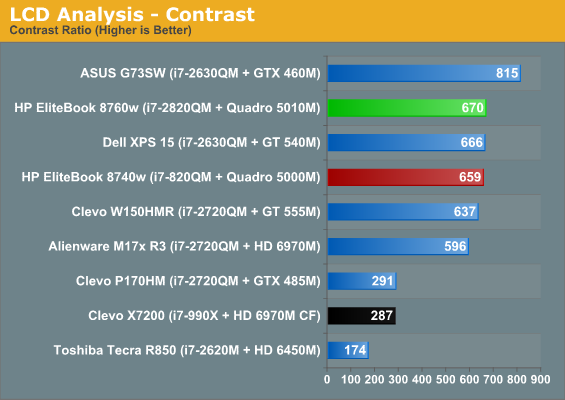
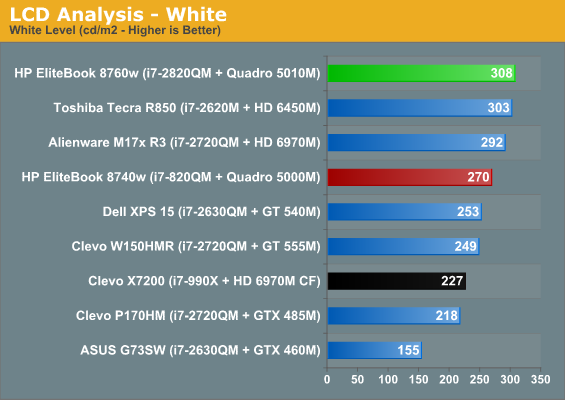
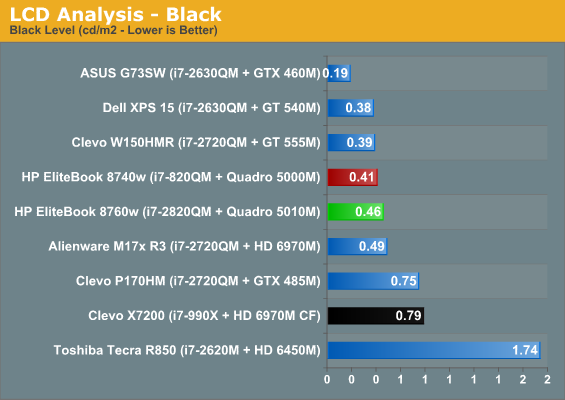
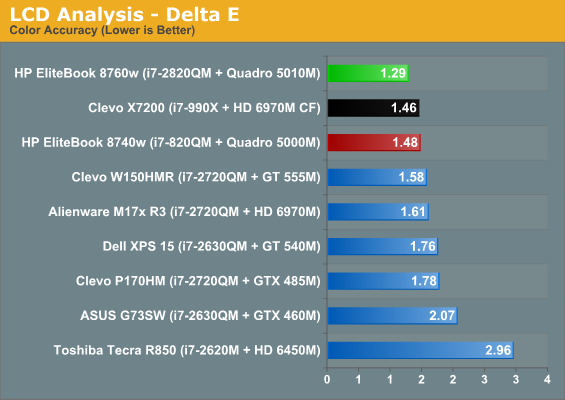
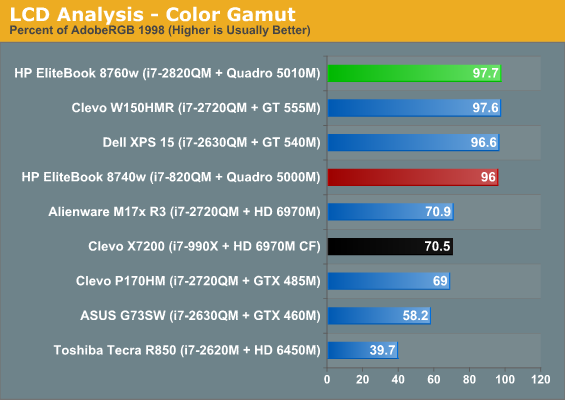
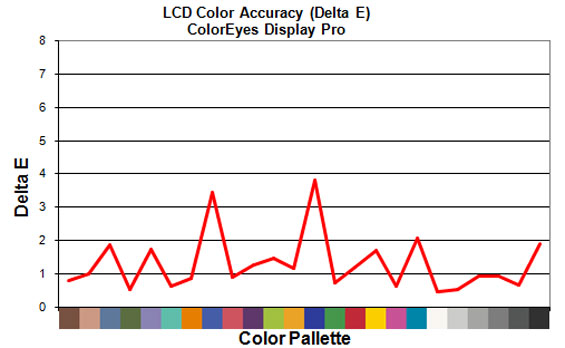
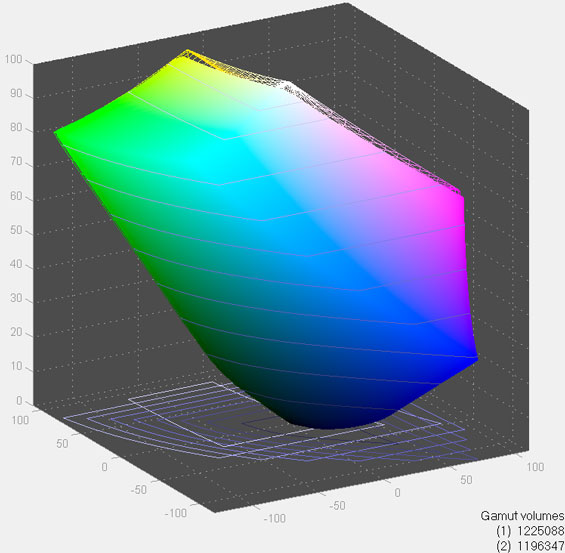
At least we can take comfort in knowing the 1080p DreamColor IPS display is a slight upgrade to its predecessor. Once again, the screen's Delta E doesn't peak and valley anywhere near as much as many cheaper TN panels do, and the color gamut offered is frankly outstanding. Contrast is also excellent, though the 8760w's panel does suffer from ever so slightly higher black levels than its predecessor.
As befitting an IPS panel, viewing angles on the 8760w are fantastic. Honestly, the screen really needs to be seen in person to be believed. Colors pop beautifully (and may actually feel oversaturated thanks to the high color gamut), and at least our gaming tests never looked more vibrant and alive...except on the 8740w. That's why it stings so much to have lost the 120 pixels of vertical real estate; DreamColor is a costly $650 upgrade ($100 more than last generation!) as it is.















83 Comments
View All Comments
Impulses - Thursday, August 25, 2011 - link
HP should showcase it at retail to show people what they're missing... You can't even buy desktop IPS screens at a brick & mortar store anymore, it's sad. I'm about to but three 1920x1200 displays (ZR24W or possibly the new Dell if I can get a discount) and I'm already dreading the day one of them dies, because I know I'll have even less options by then.Roland00Address - Thursday, August 25, 2011 - link
Ever since LG has made E-IPS screens you been seeing a steady decrease in prices for ips screens. This has accelerated now that LED monitors are the norm.Yes you can get IPS at B&M, and you can get them for $150 to $300 dollars. Currently microcenter has lg ips 226v for $159, bestbuy has lg ips 236v for $199, frys has lg ips 231p for $199. LG also designs the panels that other manufactures then use, Asus, Dell, HP, and Viewsonic all have ips monitors, and some of the monitors are in various B&M.
Dustin Sklavos - Friday, August 26, 2011 - link
The problem is that these eIPS screens are 6-bit color and not 8-bit. I think they're still a major improvement on TN and would love to see the market shift over to them, but they're not as good as full-on IPS panels (although I still very much prefer *VA panels for their deeper, inkier blacks.)DanNeely - Friday, August 26, 2011 - link
While they're better than TN, I dislike *VA for blackcrush. That's when the lowest 5-10% of the brightness all appear equally dark from head on, but pop up when looking from an angle. Hubble galaxy pictures tend to demonstrate this effect well since the edges of the galaxy generally fade down to the background black in a relatively smooth fashion.Dustin Sklavos - Friday, August 26, 2011 - link
Honestly I found my ZR24w (IPS) to crush blacks far worse than my LP2465 (*VA). A decently calibrated VA panel can produce fine detail in the darks, but the shimmer on an IPS panel's black drives me insane.DanNeely - Friday, August 26, 2011 - link
Odd. My NEC 2090's and 3090 are blackcrush free. I have an HP panel I never tested for it, will take a look when I get home. I've never noticed anything that could be called shimmer on my screens; but I've never looked either...velis - Friday, August 26, 2011 - link
Yep, agree with Dustin. This monitor is WAY better than my U2711, not to mention that it consumes A LOT less power. The U2711 heats like it was intended to (do only that) while this monitor stays perfectly cool. Plus backlight uniformity issues and bad out-of-factory colors - had to calibrate to get anything resembling good colors out of it.$500 + $200 = $700 * resdiff (1,78) = $1250, not $2500 (for the same res)
I see no reason why the panel should be different except to keep the DPI lower on desktop, but I said I dream of a desktop variant of this same monitor == same panel.
Much more competitive market == much lower prices. Limited to mfg options = higher prices.
Agree about targeted pricing for a market, but I don't agree with the premium HP charges to this market.
As far as I'm concerned, I super love this display and would gladly see it duplicated for my desktop. I hated the U2711 for its heating before, now I just do most of my work on this one... But I do agree a comparison would be in order. Mostly a $200 1080p desktop IPS will more than adequately serve as the primary screen for a crappy 1080p laptop. The dreamcolor is definitely expensive, but IMO it's worth it at this price point. Not so much at $2500 :P
velis - Friday, August 26, 2011 - link
Forgot to mention:You really have to see this monitor with your own eyes to see how good it really is. The colors are just so ... smooth ... I'm not sure it can even be described. Like the display was soothing your eyes as you look at it.
Not to mention it's uniformity which compared to other LCDs is just about what LCD geometry is to CRTs.
wsaenotsock - Thursday, August 25, 2011 - link
Well, looks like the workstation & enterprise products are finally succumbing to the market forces behind 16:9 panels. Oh, and simultaneously charging more for the IPS upgrade as well. Margins must be really tight.alpha10 - Thursday, August 25, 2011 - link
I would like to see the 2 full HD screens compared for the 8760w.I did a comparison with the 8560w, and wasn't impressed by the Dreamcolor, the "grain" or "sparkle" was too much for me, the regular screen looked a lot cleaner and nicer. Obviously the Dreamcolor has much better viewing angles, but who cares about this when working and looking at the screen at an optimal position? I also found the over-saturated colors to be too much. For a web designer all the colors were too strong, I had to set the color profile down to sRGB to get correct colors.
I ended up buying the 8760w with the regular screen, after a calibration using Spyder 3 Elite, the colors are perfect, gone is the blue tint that most TN panels have.